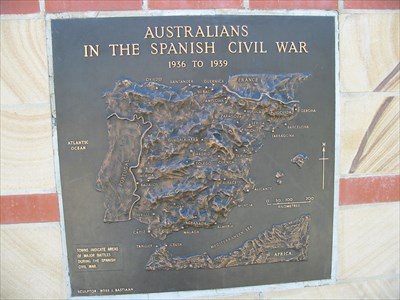We welcomed John Rodriguez to talk on “Living under Franco“. John spoke of his childhood in Spain and the impact on his family and community of the Franco dictatorship.
Just by chance, today is the 43rd anniversary of Franco’s death. In Spain there was a vote in the Congress to remove his body from “El Valle de los Caidos”, the valley of the fallen. Franco did not die in the Civil War (1936-39), which this valley commemorates. His family want to rebury him in a cathedral in central Madrid, a request the Spanish government has rejected. While this stand-off continues, he lies still where he was first buried.
John reminded us that on the first Sunday of December from noon onwards, there is a picnic at Lennox Gardens to pay homage to Australians who fought in the Spanish Civil War. All are welcome to attend, and the Spanish community cooks paella.
[Lennox Gardens memorial plaque photo: Wikimedia Commons]
John spoke about his childhood in Malaga, on the south coast of Spain. Fear controlled their lives, fear of the authorities, fear that the neighbours might report the family to the authorities. His father was a Republican, and they were not religious, so there was also the fear that the local priest might report them.
John was from quite a poor family. He had 2 brothers and 3 sisters. His brother Alfonso made a transistor radio for the family so they could listen to music and official government news. They could also tune in to alternative radio stations (the Resistance) and find out what the Government was doing. The sound of trumpets was used to mask the sounds of people being beaten and tortured by the Guardia Civil, and he knew people who died at their hands.
At the age of 5 John went to school and was beaten on the first day – he had not asked permission to enter the classroom!
His father died when he was only 7 years old. He resisted the priest’s attempt to give him extreme unction, and the family had to make up a story to cover for this.
In 1961 Franco visited Malaga and John was lined up with the other students to see him, but the cars had darkened windows, and he never actually saw him. John left school at 12, but later was enrolled in a school that taught him English and French, after which he got a job in the Moro olive oil company which his father had worked for. At 17 he moved to Barcelona, and because he claimed he was an electrician, he got a job in a workshop. When they found out that he wasn’t an electrician, he was given a job in charge of the workshop. He moved back to Malaga, and eventually migrated to Australia.
John visited Spain several times after that, and then returned, planning to live there, in 1977. On multiple occasions he and his partner were harassed and threatened by police thugs who were “remnants” from Franco’s regime (Franco had died in 1975).
Jane thanked John for his enlightening talk and promised to deliver a VR mug to him soon.
The memorial wall in Lennox Gardens, Canberra, carries a relief map of Spain, and a plaque with the following text:
This monument honours the 70 Australian men and women who went to Spain during the Spanish civil war of 1936-39 to defend the cause of the Spanish republic.
A republican government was elected in Spain in 1931 and a democratic constitution promulgated. In July 1936 a group of generals led by Francisco Franco staged a military uprising against the popular front government precipitating a bloody civil war. When the conflict ended in 1939 general Franco’s nationalist forces controlled the country.
During the civil war some 50,000 supporters from 53 countries went to Spain to defend the republic. For them the Spanish civil war represented the first battle in a larger war against fascism.
The Australian writer Nettie Palmer who was in Barcelona when the uprising occurred said of those who supported the Spanish republic: “though they were few in number and not powerful and seemed often to be shouting against the wind theirs was truly a brave chapter in Australia’s history”.
This monument erected by the Australians in Spain memorial committee was dedicated on 11 December 1993 by Lloyd Edmonds, international brigade veteran.
